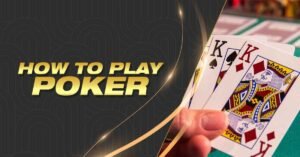Mastering the Basics – A Comprehensive Guide on How to Play Poker
As far back as the sixteenth century, Germans engaged in a bluffing game named “Pochen.” This evolved into the French version called “Poque,” which eventually found its way to New Orleans and became a favorite on the riverboats navigating the Mississippi.

In the 1830s, the game underwent further refinement and earned the name “Poker.” During the Civil War, a crucial rule was introduced, allowing players to draw cards to enhance their hands. Around the same time, a variation called Stud Poker emerged. With hundreds of Poker versions available, the game extends beyond private homes to Poker rooms in renowned casinos. Poker accommodates all levels, played casually for pennies or more competitively for significant sums.
While luck plays a part in Poker, the game demands considerable skill. Each player holds the reins to their destiny, making Poker a blend of chance and strategic mastery.
Poker Hand Rankings
Before diving into our poker guide, let’s familiarize ourselves with the 10 basic hand combinations and their rankings. Here’s a quick overview:

Fun Fact: The probability of getting a Royal Flush is 1 in 649,739.
Bluffing in Poker
Winning at poker doesn’t always require having the best hand. You can achieve victory by bluffing your opponents. Bluffing means projecting confidence in your hand through strategic betting, making it seem better than it is. The idea is to make your opponents believe you have a strong hand, prompting them to fold rather than face you in the showdown.

Forced Bets in Poker
Most poker variations include compulsory bets at the beginning of each hand, commonly known as the ‘ante’ or ‘blind.’ Some games have a small blind and a big blind, with the big blind usually being twice the size of the small blind.

Understanding the Dealer’s Role
Whether you’re playing poker at home, in a physical casino, or online, the dealer plays a crucial role in determining the order of blinds and player bets. The game typically progresses in a clockwise direction, starting with the dealer.

In both physical and online casinos, the dealer is usually not one of the players. Instead, a token designates which player acts as the dealer for each hand, rotating clockwise from one hand to the next.
Betting Options
After the mandatory bets, the first round of betting kicks off. Players typically have these betting options, depending on how confident they are in their hand:

Initiating Your Poker Journey: How to Play Poker
In Texas Hold’em, each player receives two face-down cards known as hole cards. These cards are exclusively for your eyes and should remain a secret from other players. After all cards are dealt, the two players seated clockwise from the dealer button (the one dealing) are required to place the small and big blind, also known as the ante. These blinds ensure there are chips on the table for each round, with the big blind typically being double the amount of the small blind. For this example, let’s set the blinds at $1 and $2.

To proceed to the next round, all players must at least match the big blind; this is known as a Call. Players also have the options to Fold or Raise. Folding means exiting the current round and giving up your two cards. If you choose to Raise, you not only match the current bet but increase the price for further participation in the game.
The Flop
Following the first betting round, three new cards are revealed on the table for everyone to see. This set of cards is known as the flop (check the image from EasyPoker for reference). These cards are referred to as Community Cards, intended for all players to use in combination with their individual hole cards.
After the flop, another round of betting ensues, starting with the player to the left of the dealer. To stay in the round, all players must match the highest bet, similar to the initial betting round. Unlike the first round, players now have the additional option to check, indicating a decision not to bet or fold. Choosing to check allows you to proceed to the next round, but only if no other player places a bet. If another player makes a bet, you must decide whether to fold, call, or raise.
The Turn
After the flop, the dealer discards the top card of the deck (referred to as “burning” the card) by removing it and setting it aside. Following this, the dealer places another card face up on the table. With this addition, there are now four community cards available to all players.
Subsequently, there is another round of betting, maintaining the same format as the previous round. Players can decide to fold, call, or raise based on their assessment of the developing hand.
The Final Card (River)
In the final stage, known as the River, the dealer discards yet another card from the top of the deck (burning it) and reveals the fifth and last community card for the table. Following this, there is one last round of betting before players must reveal their cards.
To determine the winner, the player with the highest 5-card combination, combining their hole cards and the community cards, takes the entire pot—the total chips betted during the round. Subsequently, the roles of the dealer, small blind, and big blind shift clockwise. All the cards are then shuffled, and the process begins anew for a fresh round.
Betting Structures and Limits in Poker
In poker, there are several common betting structures, with the three main types outlined below. These structures are typically featured in online poker lobbies, associated with the specific poker variant being played.
Pot Limit (PL)
Participants have the option to wager or increase their bets by any amount, up to the size of the entire pot. The betting amount is restricted by the current pot size.
Fixed Limit (FL)
Betting and raising must be done by fixed, predetermined amounts. Players are limited to specific increments when placing bets or raising.
No Limit (NL)
Players have the freedom to bet any or all of their chips at any point when it’s their turn to bet. There are no restrictions on the betting amount, providing an open and dynamic betting environment.
FAQs
Conclusion
In conclusion, mastering the fundamentals of poker, as explored in this comprehensive guide, involves understanding its historical evolution, the hierarchy of hand rankings, strategic elements like bluffing, and the dynamics of betting structures. Whether playing casually or competitively, the blend of chance and skill in poker offers a rich and dynamic experience for players, making it a timeless and enduring card game. So, armed with knowledge of the basics and nuances, enthusiasts can confidently navigate the world of poker and enjoy the excitement it brings to tables worldwide.
















